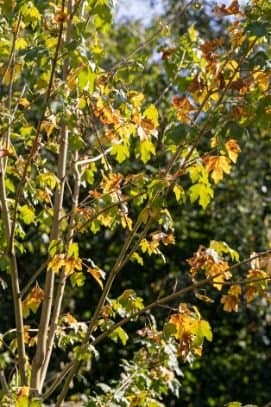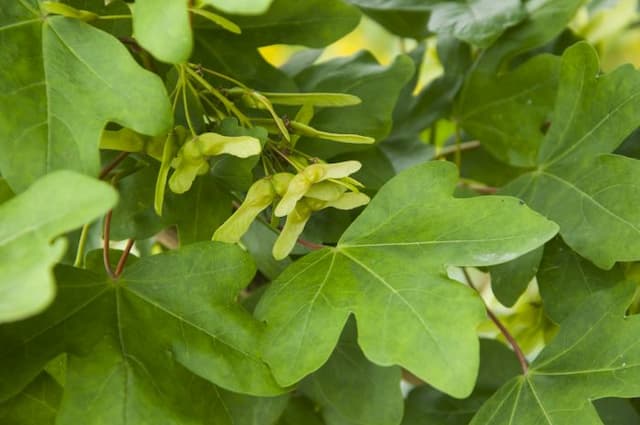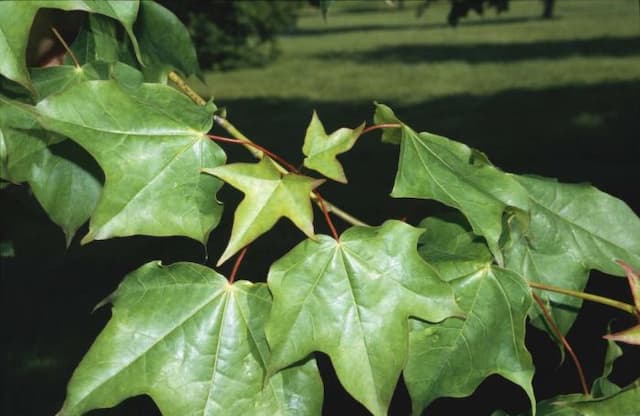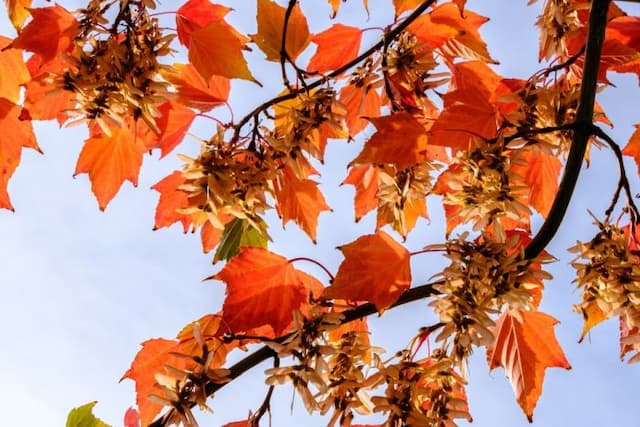Sycamore Maple Acer pseudoplatanus

ABOUT
The Acer pseudoplatanus, commonly known as the sycamore maple, is a deciduous tree often recognized for its distinctive leaves and bark. The leaves of the sycamore maple are large, with five lobes, and have toothed edges. They display a rich green color on the top surface, while the underside is a paler green, sometimes with a slight grayish tinge. These leaves are arranged in opposite pairs along the branches. In spring, the sycamore maple produces flowers in hanging clusters, known as panicles. The flowers are small and yellow-green in color, which turn into characteristic winged fruits, called samaras. Each samara has two wings that spread almost horizontally, which help in the wind dispersal of the seeds. The bark of the sycamore maple is another notable feature, initially smooth and gray when young, but as it matures, it develops into a pattern of brownish flakes that can peel away, giving it a somewhat rugged, patchy appearance. The younger twigs may have a reddish-brown hue and are generally smooth to the touch. In autumn, the foliage of the sycamore maple stands out when its leaves turn a vibrant shade of yellow or brown, before falling as the tree prepares for the winter season. The overall form of the tree is rounded, with a branching pattern that provides dense foliage and creates a canopy that is appreciated for its shade-giving qualities.
About this plant
 Names
NamesSynonyms
Sycamore Maple, Sycamore, Great Maple, Scottish Maple, Planetree Maple.
Common names
Acer pseudo-platanus L., Acer montanum Salisb., Acer procerum Salisb., Acer majus Gray, Dippel, Acer melliodorum Opiz, Acer tomentosum Tausch, Acer abchasicum Rupr., Acer hyrcanum Fisch. & C.A.Mey., Acer insulare Tausch, Acer laetum C.A.Mey., Acer lobelii Ten., Acer opulifolium Bubani, Acer platanoides var. lobelii (Ten.) Nyman, Acer platanoides var. opulifolium (Bubani) Simonk., Acer platanoides subsp. pseudoplatanus (L.) E.Murray, Acer purpureum Ehrh., Acer variegatum Ehrh., Acer worleei Dippel.
 Toxicity
ToxicityTo humans
The Acer pseudoplatanus, commonly known as the sycamore, is generally not considered highly toxic to humans. However, ingestion of its seeds or sap in large quantities can potentially cause some health issues due to the presence of certain compounds. There have been some reports linking the sycamore to cases of equine atypical myopathy in horses when they ingest large amounts of the seeds or seedlings—a condition which can be fatal. In humans, while the risk is much lower, symptoms of poisoning may include gastrointestinal upset, such as nausea, vomiting, or diarrhea. Those who handle the plant might also experience skin irritation or allergic reactions. It is advisable to avoid consuming parts of the sycamore tree and to handle it with care, especially if you have sensitive skin.
To pets
The Acer pseudoplatanus, known as the sycamore, poses some toxicity risks to pets, particularly horses. Its seeds and seedlings contain the toxin hypoglycin A, which can cause equine atypical myopathy—a serious muscle disease that can be fatal in horses. Symptoms of poisoning in horses may include muscle stiffness, weakness, collapse, and in severe cases, even death. While toxicity in household pets such as dogs and cats is less commonly reported, it is still advisable to prevent your pets from ingesting parts of the sycamore tree, as the potential effects are not fully understood. Pet owners should monitor their animals and consult a veterinarian if they suspect ingestion of sycamore seeds or seedlings.
 Characteristics
CharacteristicsLife cycle
Perennials
Foliage type
Deciduous
Color of leaves
Green
Flower color
Yellow-green
Height
60-100 feet (18-30 meters)
Spread
40-60 feet (12-18 meters)
Plant type
Tree
Hardiness zones
5-7
Native area
Europe
Benefits
 General Benefits
General Benefits- Shade Provider: Sycamore offers dense foliage that creates cool, shaded areas in landscapes.
- Ornamental Value: With its attractive bark and stately form, sycamore is widely used for decorative purposes.
- Wildlife Habitat: The tree provides shelter and nesting sites for birds and other wildlife.
- Erosion Control: The robust root system can help stabilize soil and prevent erosion.
- Carbon Sequestration: Like other trees, sycamores capture carbon dioxide, helping to mitigate climate change.
- Windbreak: Tall and sturdy, sycamores can be planted to reduce wind speed and protect areas from harsh winds.
- Sound Barrier: The dense canopy can help reduce noise pollution when planted along roads or around properties.
- Recreational Space: Sycamore groves can serve as tranquil and scenic spaces for outdoor activities.
- Seasonal Interest: Sycamores display a variety of seasonal changes, such as vibrant autumn foliage and distinctive winter bark.
- Wood Production: Sycamore wood is used for various applications, including furniture making and musical instruments.
 Medical Properties
Medical Properties- This plant is not used for medical purposes.
 Air-purifying Qualities
Air-purifying QualitiesThis plant is not specifically known for air purifying qualities.
 Other Uses
Other Uses- Woodworking: Sycamore wood is highly valued for its workability and finish, making it popular for furniture, musical instruments, and kitchenware.
- Dye Production: The leaves and bark of the sycamore tree can be used to produce dyes for textiles.
- Horticultural Art: Sycamore branches and leaves can be used in floral arrangements or as part of bonsai practices.
- Wood Carving: The fine grain of sycamore wood makes it suitable for detailed carving, used in both artistic and utilitarian objects.
- Veneer Production: Sycamore wood is sliced into thin layers to produce veneers for paneling, furniture, and inlay work.
- Sound Boards: The tonal quality of sycamore makes it suitable for the sound boards of pianos and other stringed instruments.
- Butcher Blocks: The hardness and tight grain of sycamore wood make it ideal for butcher blocks and cutting boards.
- Turnery: Sycamore is used in the craft of turnery to make a wide array of wooden objects on a lathe, including bowls and spindles.
- Mast Production: Historically, sycamore wood was used in Europe for making masts and spars for ships due to its strength and flexibility.
- Shelter for Wildlife: Standing or fallen sycamore trees provide habitat and shelter for various species of birds and mammals.
Interesting Facts
 Feng Shui
Feng ShuiThe Sycamore Maple is not used in Feng Shui practice.
 Zodiac Sign Compitability
Zodiac Sign CompitabilityThe Sycamore Maple is not used in astrology practice.
 Plant Symbolism
Plant Symbolism- Strength and Endurance: The Acer pseudoplatanus, commonly known as the Sycamore Maple, is known for its hardy nature and ability to thrive in various conditions, symbolizing resilience and the capacity to endure challenges.
- Longevity: As a species that can live for many years, the Sycamore Maple represents long life and lasting presence.
- Protection: With its broad canopy, the Sycamore Maple offers shade and shelter, symbolizing protection and care for others.
- Growth and Expansion: The widespread growth of the tree represents personal growth, development, and the expansion of one's boundaries.
- Adaptability: Its ability to adapt to different soils and climates stands for versatility and the aptitude to adjust to changing situations.
 Water
WaterThe Sycamore Maple, or Acer pseudoplatanus, prefers consistent moisture and should be watered deeply once a week during dry periods. In the absence of rain, provide about 10-15 gallons of water to thoroughly saturate the root zone. During the growing season in spring and summer, keeping the soil consistently moist is particularly important. However, avoid overwatering as this can lead to root rot. Reduce the frequency of watering in fall and further in winter when the plant is dormant.
 Light
LightThe Sycamore Maple thrives in a range of light conditions, from full sun to partial shade. It is best to plant it in a spot where it can receive at least four to six hours of direct sunlight daily. While tolerant of light shade, the tree will have the most vigorous growth and the best fall color when placed in a brighter location.
 Temperature
TemperatureThe Sycamore Maple can tolerate a wide range of temperatures, making it a hardy choice for many landscapes. It can survive in temperatures as low as -20°F and as high as 90°F but thrives in climates with temperatures between 50°F and 75°F. It is important to protect the tree from extreme heat and cold winds.
 Pruning
PruningPruning the Sycamore Maple should be done to remove dead or damaged branches, improve the tree's shape, and prevent disease. The best time to prune is late winter or early spring before new growth begins. It is typically not necessary to prune annually, but inspecting the tree each year for trimming requirements is a good practice.
 Cleaning
CleaningNot needed
 Soil
SoilSycamore maple thrives in well-drained, moist soil rich in organic matter with a pH of 5.5 to 7.0. A blend of loam, compost, and sand in equal parts works well to support its growth.
 Repotting
RepottingSycamore maples should be repotted every 2 to 3 years or when they become root-bound, ensuring they have enough space to grow.
 Humidity & Misting
Humidity & MistingSycamore maples prefer moderate humidity levels but are adaptable to a wide range of conditions, as long as they are not in an overly dry environment.
 Suitable locations
Suitable locationsIndoor
Not ideal indoors; requires space, light.
Outdoor
Plant in sun/part shade, space to grow.
Hardiness zone
4-7 USDA
 Life cycle
Life cycleAcer pseudoplatanus, commonly known as the Sycamore Maple, begins its life cycle when the winged seeds, known as samaras, germinate in moist and well-drained soil. The seedlings emerge with two cotyledons and develop into juvenile trees which exhibit rapid growth and can tolerate a wide range of soil types. As the Sycamore Maple matures, it develops a broad, domed crown with a robust and thick trunk, establishing itself as a long-lived deciduous tree. The tree reaches reproductive maturity and starts to produce flowers in early spring, with small, green-yellow clusters pollinated by wind. Following pollination, the tree bears its characteristic samaras that ripen by late summer to autumn and are dispersed by wind to propagate the next generation. In its mature stage, the Sycamore Maple can live for hundreds of years, contributing to forest ecosystems and serving as a habitat for various wildlife species before eventually entering senescence and completing its life cycle.
 Propogation
PropogationPropogation time
Late Spring
The Acer pseudoplatanus, commonly known as the Sycamore Maple, can be propagated by seed, which is one of the most popular methods. The best time to propagate by seed is in the late winter to early spring. Seeds should be cold stratified, which involves mixing the seeds with slightly moist sand or peat and storing them in a refrigerator at around 34-41 degrees Fahrenheit (1-5 degrees Celsius) for around 1-2 months. This simulates winter conditions and helps to break dormancy. After stratification, the seeds are sown in a well-draining soil mix, covered lightly with soil, and kept at a temperature of about 70 degrees Fahrenheit (21 degrees Celsius) until germination, which generally takes between 2 to 6 weeks. Seedlings can then be gradually hardened off to outdoor conditions before being transplanted to their permanent location.







![Freeman maple [Autumn Blaze]](/_next/image?url=https%3A%2F%2Fplants-admin.emdemapps.com%2Fimages%2Fplants%2F%2Fimages%2F604b575b84d87.png&w=640&q=75)

